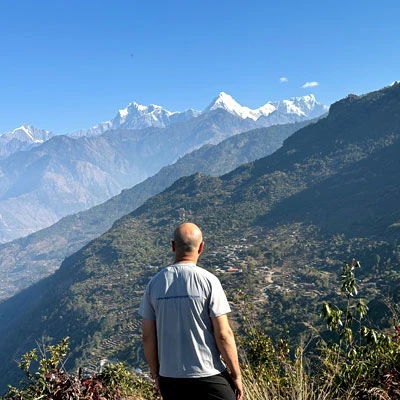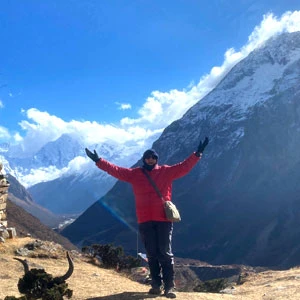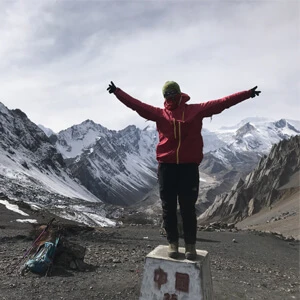Quick Overview Of The Tsum Valley Trek In Nepal
The Tsum Valley Trek in Nepal is one of the most isolated and spiritually rich journeys in the Himalayas. Officially opened to trekkers only in 2008, this restricted area trek has preserved its pristine landscapes, authentic Tibetan Buddhist culture, and untouched Himalayan wilderness.
This challenging Tsum trek spans approximately 160 to 200 kilometers round trip, depending on your itinerary and acclimatization schedule. Most itineraries last 14 to 18 days, starting at an altitude of around 930 meters and gradually ascending to the Mu Gompa monastery. The trek reaches its highest elevation at 5,093 meters / 16,079 feet near the Tibet border, where thin air and extreme remoteness add to the overall Tsum Valley trek difficulty.
As a tea house trekking route, Tsum Valley offers basic accommodations across isolated villages. Altogether, Tsum Valley is raw, rugged, and off the beaten path.
How Difficult Is The Tsum Valley Trek?
The Tsum Valley Trek difficulty is considered moderate to challenging; hence, it is better suited if you have prior high-altitude trekking experience. Along the journey, you will navigate a wide range of trail conditions, from lowland river valleys to steep ascents and descents leading into high-altitude plateaus above 3,000 meters. Later, the route becomes progressively tougher as you approach Mu Gompa and the Tibet border.
Unlike more commercial routes like Annapurna or Everest, the Tsum Valley trail is isolated, with limited infrastructure, scarce mobile connectivity, and fewer fellow trekkers.
Key Factors That Make the Tsum Valley Trek Difficult
Long walking days, basic teahouse facilities, remote trails with limited access to supplies or medical help, high altitude, and minimal acclimatization time all contribute to its overall challenge.
Trek Duration and Daily Walking Distance on Tsum Valley Trek
The trekking duration and daily walking hours significantly influence the overall Tsum Valley Trek difficulty. Most standard itineraries range from 14 to 18 days, depending on the chosen route, acclimatization schedule, and individual fitness level.
Covering approximately 160 to 200 kilometers, you will trek for anywhere between 5 to 7 hours per day. Though on certain days, particularly those involving steep ascents to high-altitude villages like Mu Gompa, the trekking hours can stretch up to 8 hours or more.
Due to the remoteness of the Tsum Valley region and the limited number of teahouses, some days may even require longer walking distances just to reach basic accommodation. Here, the lack of frequent stopovers can make fatigue more intense.
Altitude Challenges and Risk of AMS on Tsum Valley Trek
One of the major contributors to the overall Tsum Valley Trek difficulty is the altitude gain and the associated risk of Acute Mountain Sickness (AMS). The highest point on the trek lies at the Tibet border, near Ngula Dhojhyang Pass, at an elevation of 5,093 meters / 16,079 feet. At this height, altitude sickness becomes a serious concern, especially if you are unaccustomed to high-altitude trekking in Nepal.
During this trekking adventure, you will start the journey at around 930 meters and gradually climb through isolated Himalayan villages, such as Chumling, Chhokangparo, and Nile, before reaching Mu Gompa (3,700 meters) and Gompa Lungdang (3,400 meters). Despite the gradual ascent, you can still experience AMS if you ascend too quickly or ignore early symptoms like headaches, nausea, fatigue, and shortness of breath.
Because the Tsum Valley region is remote and lacks immediate emergency medical support, prevention is critical. You must hike slowly, stay hydrated, and allow time for proper acclimatization. You must also be able to recognize early signs of altitude sickness and adjust your pace can significantly.
Trail Conditions and Terrain Difficulty in Tsum Valley
The terrain and trail conditions of the Tsum Valley Trek is quite remote, especially as you venture deeper into the Himalayan region of Nepal. Its trail is filled with steep ascents and descents, particularly when approaching highland monasteries such as Mu Gompa and Gompa Lungdang.
You must navigate narrow, rugged paths that often cling to cliffsides. You will also walk through dense pine and rhododendron forests and traverse loose rocky ridgelines. The off-the-beaten-path nature of the Tsum Valley means that trails are unmaintained and wild, offering a raw trekking experience far different from Nepal’s commercial routes.
Additionally, you will also cross numerous suspension bridges, some of which sway above fast-moving glacial rivers. These crossings will demand balance and focus, especially during windy weather or after rainfall when trails become slippery and more difficult to manage.
Tsum Valley Trek Remoteness and Access Issues
Reaching the trailhead of the Tsum Valley Trek itself is an adventure. You will begin with a long and often exhausting 8 to 9-hour drive from Kathmandu to Machha Khola, navigating bumpy roads, steep mountain cliffs, and landslide-prone zones in Nepal’s Gorkha District.
Once on the trail, the isolation deepens. As you ascend into higher altitudes, mobile networks disappear, and internet access becomes virtually nonexistent. Here, communication is also limited to rare points with satellite phones.
Moving on, this remote trekking route in Nepal also brings significant challenges during emergencies. There are no hospitals or reliable medical facilities beyond the lower villages like Jagat or Philim. If you experience altitude sickness, injury, or severe fatigue, evacuation can take hours or even days, depending on your location and weather conditions.
Accommodation and Food Options in Tsum Valley Region
Accommodation and food along the Tsum Valley Trek are as humble and authentic as the valley itself. Throughout the trek, you will stay in basic tea houses, which are often family-run lodges constructed from stone and wood in traditional style. These tea houses offer modest rooms with a simple bed, a thin mattress, and thick blankets. Heating is usually limited to a central wood or yak-dung stove in the communal dining area, and hot showers, if available, typically cost extra.
Now, when it comes to food, the options are limited but nourishing. Dal Bhat (a traditional Nepali meal of rice, lentils, and vegetables) is the staple dish and is served daily, often twice, and provides the main source of energy for trekkers. You may also find Tibetan bread, noodles, fried rice, and basic soups, but the variety becomes increasingly sparse at higher altitudes near Mu Gompa and Gompa Lungdang.
Because this is a tea house trek in a restricted area, you won’t find modern comforts or gourmet meals.
Seasonal Weather Challenges During Tsum Valley Trekking
For the safest and most enjoyable Tsum Valley experience, you must plan your trek during Nepal’s peak trekking seasons: Spring (March to May) and Autumn (September to November). These months offer the most stable weather, with clear skies, moderate daytime temperatures, and dry trails, especially as you climb toward Mu Gompa and other high-altitude villages.
If you are trekking in Spring, the trails are vibrant with blooming rhododendrons, and the risk of weather-related disruptions is low. Now, if you are trekking in Autumn, you will get to enjoy crisp mountain air, stunning views of the Ganesh Himal range, and excellent trail conditions.
However, trekking Tsum Valley in the off-seasons: Winter (December to February) and Monsoon (June to August) dramatically increases the difficulty of the Tsum Valley Trek, and Nepal Trekking Experts do not recommend these seasons at all. During Monsoon, the region experiences heavy rainfall, muddy and slippery trails, swollen rivers, and an increased risk of landslides on narrow mountain roads, particularly between Machha Khola and Jagat.
In contrast, Winter trekking presents a different set of challenges. You will notice the temperatures plummet below freezing at altitudes above 3,000 meters, and snow-covered trails become icy and hazardous.
Mental and Emotional Challenges on Tsum Valley Trail
As you journey into one of Nepal’s most secluded trekking regions, far from the crowded trails of Everest or the Annapurna, you may face a major toll on your mental health.
Especially during the off-peak trekking seasons, you may trek for hours without encountering another traveler, apart from the occasional yak herder or local Buddhist monk. For some, this deep solitude in the Gorkha region offers peace and spiritual connection. For others, it may trigger feelings of loneliness, emotional fatigue, or even disorientation.
Here, the lack of social interaction, minimal creature comforts, and absence of consistent digital connectivity can make the journey mentally taxing, particularly with over two weeks of high-altitude trekking through harsh, rugged terrain. To cope with these psychological demands, you will need a strong mindset, patience, and the ability to embrace solitude.
Physical Fitness and Trekking Experience for Tsum Valley
The Tsum Valley Trek is best suited for adventurous souls who thrive in off-the-beaten-path challenges; hence, you will need a solid level of physical fitness and mental resilience. This remote Himalayan trek in Nepal requires you to walk for 5 to 7 hours per day, often on steep inclines, rocky trails, and at elevations above 3,000 meters.
To prepare for Tsum Valley, you will need to start a training routine at least 3 to 4 weeks in advance. Here, you must focus on cardiovascular workouts such as brisk walking, hiking, running, or cycling to improve stamina. It must also include strength training, especially targeting your legs and core, to better manage elevation gain and descents on uneven trails.
If this is your first trek above 3,000 meters, you should consider doing a shorter, lower-altitude trek in Nepal beforehand. This helps you understand how your body reacts to altitude and extended physical exertion.
Practical Tips to Handle Tsum Valley Trek Difficulty
- Build endurance with cardio (hiking, jogging, cycling), and strengthen your legs and core through squats, lunges, and stair climbing. Start your training at least 6 to 8 weeks before the trek.
- Pack smart and light by only carrying the essentials.
- Trek slowly and steadily with acclimatization and rest days.
- Drink at least 3 liters of water every day. Avoid drinking alcohol and caffeine at higher altitude levels.
- Don’t count on phone signals or Wi-Fi. Enjoy the digital detox and inform the family beforehand.
- Make sure that your itinerary is flexible in case of delays or weather changes that may alter your plan.
Conclusion
The Tsum Valley Trek is a raw, challenging, and profoundly rewarding journey into one of Nepal’s most sacred and untouched regions. Yes, it tests your limits with steep ascents, remote trails, basic facilities, and thin mountain air. But in return, it offers an unmatched sense of solitude, deep spiritual immersion, and views that feel like they belong to another world.
That said, this trek isn’t for everyone. If you are a first-time trekker with little preparation or someone who values comfort over adventure, you might want to build up with an easier trek first. To make the most of it, you should contact a seasoned local team like Nepal Trekking Experts.
FAQs
Is the Tsum Valley Trek suitable for beginners?
While some beginners do attempt the Tsum Valley Trek, it is better suited if you have prior trekking experience.
How long does the Tsum Valley Trek take?
The trek typically takes 14 to 18 days, depending on the route and pace.
What is the highest altitude on the Tsum Valley Trek?
The highest point of Tsum Valley is around 5,093 meters near the Tibet border at Ngula Dhojhyang Pass.
Do I need a guide for Tsum Valley trek in Nepal?
Yes, the Tsum Valley lies in a restricted area, and hiring a licensed guide is mandatory.
Is altitude sickness a risk on the Tsum Valley route?
Yes, especially above 3,000 meters, so proper acclimatization is essential.
When is the best time to trek to Tsum Valley in Nepal?
Spring (March to May) and Autumn (September to November) are the best time for the Tsum Valley Trek.
How Physically Demanding Is the Tsum Valley Trek?
Yes, as you will need to walk 5 to 7 hours daily on uneven and sometimes steep terrain.
Can I trek to Tsum Valley without a guide?
No, solo trekking is not allowed in this restricted region. You must trek with a guide and through a registered agency.







